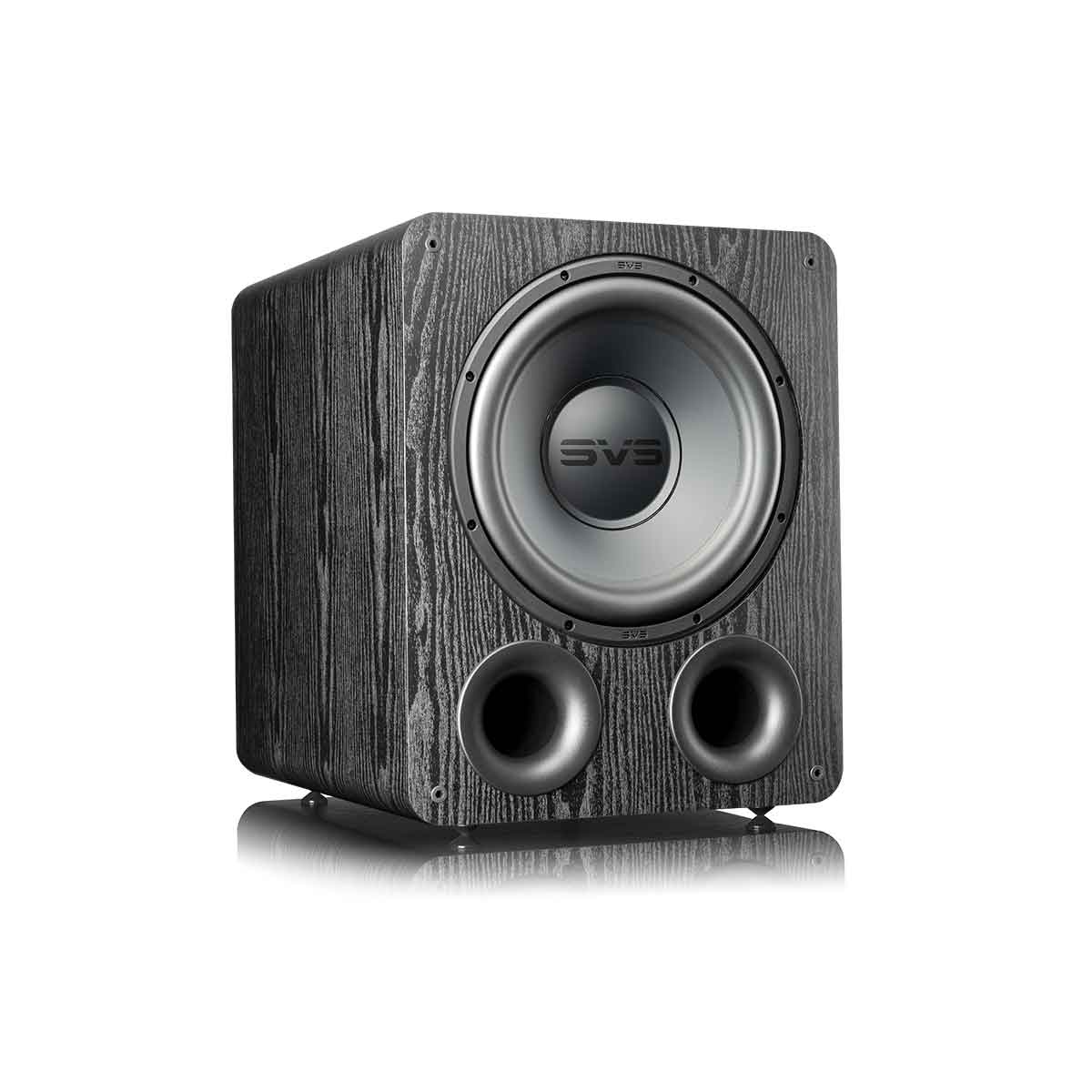Sealed vs. Ported Subwoofers

When considering a subwoofer for your home theater or listening room, there are a lot of factors to consider. We are often asked about the difference between sealed and ported subwoofers, and which they should choose for their room.
Before we do that, however, let’s quickly review the true purpose of subwoofers and how they work in different situations.
Why You Need a Quality Subwoofer
Most people think the number reason for a subwoofer is to get more bass. It’s true that subwoofers do give you more base, but did you know that if properly implemented, the right kind of subwoofer can also improve the overall sound of your main speakers?
Let’s say you have a nice pair of bookshelf or smaller tower speakers. If you are playing them without a subwoofer, they are being asked to create the entire musical frequency spectrum from the lowest lows to the highest highs. To attempt to recreate those really low notes your speakers will utilize the bass driver. It will need to be moving quite a bit. The low frequencies it creates will also shake the speaker cabinet.
So what if you took those low notes away and sent them somewhere else? Like to a subwoofer? Well, as a result, the bass driver (which if you have a small two-way system is also your midrange driver) does not have to move around as much. What you will hear is vastly improved midrange response. Plus, since the speaker cabinet is not shaking as much from the low tones, everything gets clearer too!
If you’re looking for a subwoofer for your home theater room, you want something that has the ability to deliver lots of low-end impact. The biggest thing that can affect this is the size of the room. If you have a large space, you’ll need a large subwoofer -- possibly more than one. Multiple subwoofers in a room are a great way to even out the bass response for all of the seating positions in your room so that everyone gets that same great experience.
There are lots of companies selling “boomy” subwoofers. They’re loud, but they’re not as tight, as deep, as fast, or as precise as high-quality subwoofers. For the ultimate home theater experience, you should be able to hear the difference between thunder and an explosion, or the difference between an upright bass and an electric bass.
This all brings us back around to ported vs sealed subwoofers.
Sealed Subwoofers
A sealed subwoofer is a subwoofer in a sealed box. This type of configuration can be put into a relatively small box, making placement in a room easier.
Bass Roll-off
Every speaker has a range of frequencies that it can produce -- some easier than others. When the frequency response drops off noticeable (usually in the lower frequencies), we call that bass roll-off. For example, if the roll-off started at 40Hz you would still have some bass at 30Hz, just not as loud. Sealed subwoofers typically provide a gentler bass roll-off than ported subwoofers.
Consider Timing
Particularly if you are listening to music, timing is also extremely important. You want the low notes that you sent to the subwoofer to sync up as closely as possible to the ones coming from your main speakers. Sealed subwoofers are similar to most other speakers -- the woofer is the only thing producing sound. Lining everything up is a matter of simple tuning.
As you get into larger rooms (think 2,500 cubic feet or more), however, the bass demand increases greatly. One small sealed subwoofer in a large room is not going to be enough. You’ll need larger and potentially more than one subwoofer to get the same perceived sound you get in a smaller room.

Ported Subwoofers
A ported subwoofer has the woofer and one or more ports, which let the air escape out of the box. This allows you to get a bigger sound out of one box because there are two different mechanisms moving the air -- the woofer and the port.
A ported subwoofer can move a lot of air and fill up a very large room. Because you need the space inside the box for air, ported subwoofers tend to be larger tit for tat with a sealed subwoofer. This is something to keep in mind when deciding where and how you will be placing the subs in the room.
Bass Roll-off
Ported subwoofers roll-off very fast when compared to sealed subwoofers. If you decide to go with a ported sub, you will want one with a large enough woofer to capture all of the low bass tones.
Consider Timing
Timing is can also be an issue with ported subwoofers. Think about the physics. The air moved by the woofer may sync closely with your other speakers, but the air coming from the port is just slightly behind. Ported subwoofers are harder to design properly as you need to tune the port exactly right with the box size and woofer size.
If you can keep that resonance frequency low enough, our ears will not perceive this difference.
Another issue that comes from ported designs is that some people can actually hear the sound of the air itself escaping from the port. This is known as “chuffing”.
So What Should I Buy?
Of course, you can have great ported and sealed subs and bad ported and sealed subs. But let’s say you are getting a subwoofer from a highly rated, reputable manufacturer. As with all things in making great sound, it comes down to the room. A large room (above 2500 cubic feet) will probably need either ported subwoofers or large sealed subwoofers, and more than one would be preferable. If your room is smaller than this, one or two great sealed subwoofers will usually be preferable.
If you have some great small speakers and enjoy listening to music as much or more than watching movies, you’ll likely be able to find a sub that can blend with your main speakers better if it is sealed. If on the other hand you love deep, loud bass effects and have a large room, you’ll probably wind up with a ported design.
And just to confuse you, we have on more type of subwoofer to throw into the mix. Some subwoofers are in a sealed box but have what is called a passive radiator to help extend the bass, instead of having a port. The passive radiator is moved by the back wave of air coming from the main woofer. The movement of air from the passive radiator is greater than what would come out of the port. While it’s more of a design challenge to get this right, a system like this can produce great deep bass and keep the cabinet size relatively small. A great subwoofer or two with this type of design can be a wonderful choice for a larger room, where fitting in a big ported box or two is difficult.
Ultimately the choice is yours. Of course, getting the right subwoofer is only one small battle. Placement, acoustics, tuning the room, and setting up the EQ (if you’re lucky enough to have it in your system) all play an extremely important role in how everything will sound.
If you have any questions, our team of experts is happy to help! Feel free to email us or chat us! We can answer any questions you may have and help you pick the right subwoofer for you and your room.































 Home Theater
Home Theater Speakers
Speakers Tower Speakers
Tower Speakers
 Bookshelf Speakers
Bookshelf Speakers
 Center Channel Speakers
Center Channel Speakers
 Wall & Ceiling Speakers
Wall & Ceiling Speakers
 Surround Speakers
Surround Speakers
 Dolby Atmos Speakers
Dolby Atmos Speakers
 Subwoofers
Subwoofers
 Soundbars
Soundbars
 Speaker Stands & Mounts
Speaker Stands & Mounts
 Components
Components Home Theater Receivers
Home Theater Receivers
 Surround Sound Processors
Surround Sound Processors
 Power Amps
Power Amps
 Movie Sources
Movie Sources
 TVs & Projectors
TVs & Projectors Televisions
Televisions
 Projectors
Projectors
 Projector Screens
Projector Screens
 TV & Projector Mounts
TV & Projector Mounts
 Seating & Furniture
Seating & Furniture Home Theater Seating
Home Theater Seating
 Media Cabinets
Media Cabinets
 A/V Racks & Shelves
A/V Racks & Shelves
 Accessories
Accessories
 Acoustic Treatments
Acoustic Treatments Absorption Panels
Absorption Panels
 Bass Trap Panels
Bass Trap Panels
 Diffusion Panels
Diffusion Panels
 Acoustic Treatment Packages
Acoustic Treatment Packages
 Cables & Accessories
Cables & Accessories HDMI Cables
HDMI Cables
 Analog Cables
Analog Cables
 Digital Cables
Digital Cables
 USB Cables
USB Cables
 Speaker Cables
Speaker Cables
 Subwoofer Cables
Subwoofer Cables
 Power Management
Power Management
 Featured & Deals
Featured & Deals Best Sellers
Best Sellers
 Sale
Sale
 Home Audio
Home Audio Outdoor Speakers
Outdoor Speakers
 Portable & Bluetooth
Portable & Bluetooth
 Wireless Speaker Systems
Wireless Speaker Systems
 Computer Speakers
Computer Speakers
 Powered Speakers
Powered Speakers
 Integrated Amplifiers
Integrated Amplifiers
 Power Amplifiers
Power Amplifiers
 Stereo Preamplifiers
Stereo Preamplifiers
 Stereo Receivers
Stereo Receivers
 Streaming Media Players
Streaming Media Players
 Digital-to-Analog Converters
Digital-to-Analog Converters
 CD Players
CD Players
 Outdoor Entertainment
Outdoor Entertainment Outdoor Subwoofers
Outdoor Subwoofers
 Turntables
Turntables Manual
Manual
 Automatic
Automatic
 Phono Cartridges
Phono Cartridges Moving Coil
Moving Coil
 Moving Magnet
Moving Magnet
 Moving Iron
Moving Iron
 Mono
Mono
 Phono Preamps
Phono Preamps MC Compatible
MC Compatible
 MM Compatible
MM Compatible
 Record Cleaning & Care
Record Cleaning & Care Stylus Care
Stylus Care
 Cleaning Machines
Cleaning Machines
 Record Cleaning Fluid
Record Cleaning Fluid
 Record Sleeves
Record Sleeves
 Isolation Systems
Isolation Systems Turntable Setup Tools
Turntable Setup Tools
 Turntable Cables
Turntable Cables
 Record Weights
Record Weights
 Turntable Mats
Turntable Mats
 Headphones
Headphones In-Ear Headphones
In-Ear Headphones
 On-Ear Headphones
On-Ear Headphones
 Over-Ear Headphones
Over-Ear Headphones
 Wireless Headphones
Wireless Headphones
 Gaming Headsets
Gaming Headsets
 Headphone Amps & DACs
Headphone Amps & DACs Digital Audio Players
Digital Audio Players
 Smart Home
Smart Home Deals
Deals Limited Time Deals
Limited Time Deals Deals by Category
Deals by Category
